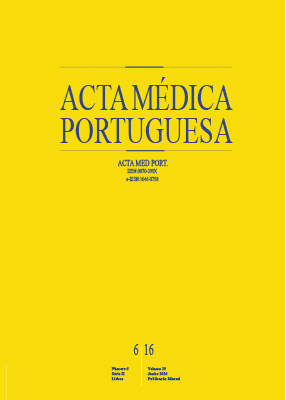Multidimensional Strategy Regarding the Reduction of Central-Line Associated Infection in Pediatric Intensive Care
DOI:
https://doi.org/10.20344/amp.5558Keywords:
Catheter-Related Infections, Central Venous Catheters, Cross Infection, Intensive Care Units, Pediatric.Abstract
Introduction: To determine the central-line associated bloodstream infection rate after implementation of central venous catheter-care practice bundles and guidelines and to compare it with the previous central-line associated bloodstream infection rate.
Material and Methods: A prospective, longitudinal, observational descriptive study with an exploratory component was performed in a Pediatric Intensive Care Unit during five months. The universe was composed of every child admitted to Pediatric Intensive Care Unit who inserted a central venous catheter. A comparative study with historical controls was performed to evaluate the result of the intervention (group 1 versus group 2).
Results: Seventy five children were included, with a median age of 23 months: 22 (29.3%) newborns; 28 (37.3%) with recent surgery and 32 (43.8%) with underlying illness. A total of 105 central venous catheter were inserted, the majority a single central venous catheter (69.3%), with a mean duration of 6.8 ± 6.7 days. The most common type of central venous catheter was the short-term, non-tunneled central venous catheter (45.7%), while the subclavian and brachial flexure veins were the most frequent insertion sites (both 25.7%). There were no cases of central-line associated bloodstream infection reported during this study. Comparing with historical controls (group 1), both groups were similar regarding age, gender, department of origin and place of central venous catheter insertion. In the current study (group 2), the median length of stay was higher, while the mean duration of central venous catheter (excluding peripherally inserted central line) was similar in both groups. There were no statistical differences regarding central venous catheter caliber and number of lumens. Fewer children admitted to Pediatric Intensive Care Unit had central venous catheter inserted in group 2, with no significant difference between single or multiple central venous catheter.
Discussion: After multidimensional strategy implementation there was no reported central-line associated bloodstream infection
Conclusions: Efforts must be made to preserve the same degree of multidimensional prevention, in order to confirm the effective reduction of the central-line associated bloodstream infection rate and to allow its maintenance.
Downloads
Published
How to Cite
Issue
Section
License
All the articles published in the AMP are open access and comply with the requirements of funding agencies or academic institutions. The AMP is governed by the terms of the Creative Commons ‘Attribution – Non-Commercial Use - (CC-BY-NC)’ license, regarding the use by third parties.
It is the author’s responsibility to obtain approval for the reproduction of figures, tables, etc. from other publications.
Upon acceptance of an article for publication, the authors will be asked to complete the ICMJE “Copyright Liability and Copyright Sharing Statement “(http://www.actamedicaportuguesa.com/info/AMP-NormasPublicacao.pdf) and the “Declaration of Potential Conflicts of Interest” (http:// www.icmje.org/conflicts-of-interest). An e-mail will be sent to the corresponding author to acknowledge receipt of the manuscript.
After publication, the authors are authorised to make their articles available in repositories of their institutions of origin, as long as they always mention where they were published and according to the Creative Commons license.









